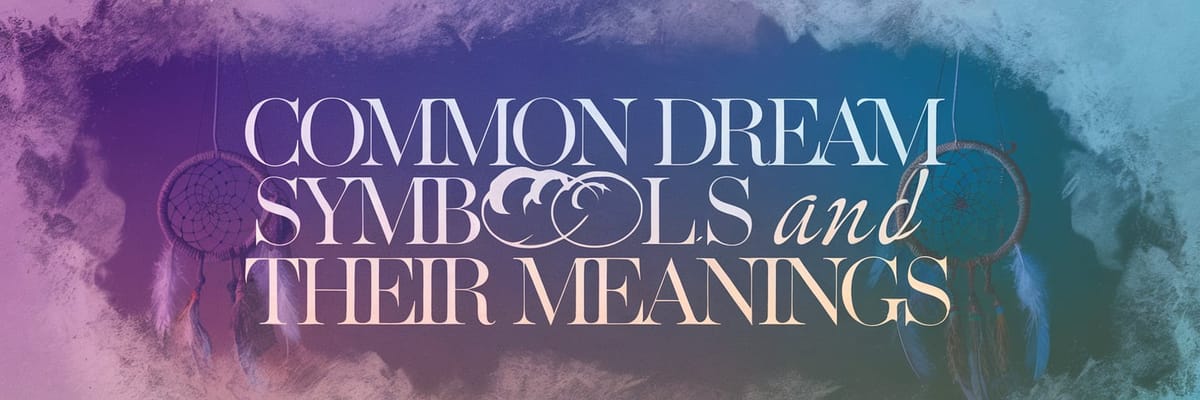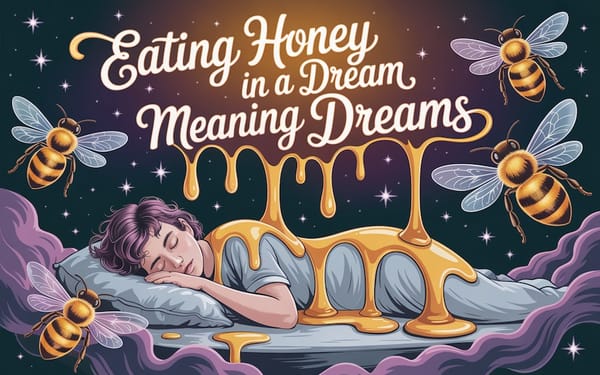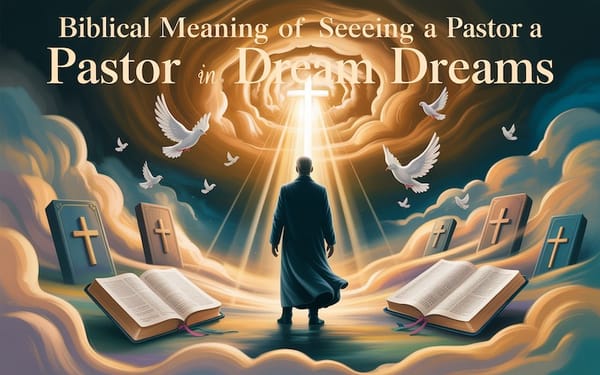Common Dream Symbols and Their Meanings: Your Ultimate Guide

Dreams are the whisperings of the subconscious, unveiling a hidden world brimming with surreal narratives and symbols that seek to illuminate the paths of our waking lives. Among these enigmatic sequences, the desire to understand dream symbols presents itself as a recurring theme that has fascinated dreamers across cultures and centuries. What compels our minds to paint these intricate canvases in the darkness of slumber? Is it a call from our inner selves or a mere shuffle of thoughts? This profound curiosity has led many to explore the depths of dreams, seeking guidance and enlightenment.
Understanding dream symbols opens a doorway to a realm where mystery, intuition, and transformation converge. From the vivid to the abstract, the symbols in your dreams may carry meanings as limitless as the imagination itself. Every culture has legends filled with tales of prophetic dreams, where symbols are the threads weaving insights and revelations. This journey of discovery might be the key to decoding personal narratives and unveiling a path to self-awareness.
In this article, we embark on an exploration of common dream symbols, delving into their symbolic, psychological, and scientific interpretations. We will equip you with insights to turn the cryptic whispers of your dreams into tangible wisdom.
The Symbolic and Spiritual Significance of Understanding Dream Symbols
Understanding dream symbols is akin to learning a language that transcends words, speaking directly to the heart and soul. In the realm of dreams, symbols are like ancient hieroglyphs—sacred images that hold power and essence beyond their surface appearance. These symbols can represent profound aspects of the human experience—independence, mystery, intuition—and their meanings are as versatile as they are universal.
Consider the endless ocean: a symbol for the unconscious mind, creativity, and the unknown. Standing before it, one might feel an overwhelming sense of freedom and fear, reflection of one's journey toward self-discovery or confrontation of deep-seated anxieties. Meanwhile, the majestic eagle soaring in the sky embodies independence and perspective, urging the dreamer to rise above challenges and embrace a broader view.

In a spiritual context, dream symbols invite introspection, serving as messengers from the soul. They encourage us to question and explore our emotions, desires, and fears, urging us to embrace transformation. These symbols spark a dialogue with our inner selves, forging a connection that can lead to enlightenment and growth.
What Do Different Understanding Dream Symbols Scenarios Mean?
Dreams involving understanding dream symbols can manifest in a myriad of scenarios, each offering a unique reflection of the dreamer's inner world. Consider some common dream scenarios and their potential interpretations:
- Teeth Falling Out: A prevalent symbol of transformation, vulnerability, or loss. Gradual tooth loss in dreams might suggest the slow erosion of confidence or power, while sudden loss could indicate a fear of losing control or facing inevitable change. Pain accompanying the event may highlight deep-seated anxieties about one's image or aging process.
- Flying: A manifestation of liberation, ambition, or escape. Soaring effortlessly can signify newfound independence, while struggling to lift off might pinpoint obstacles tethering the dreamer to reality. The sensation of flying often correlates with a yearning for freedom or an ability to rise above life's mundane challenges.
- Chasing or Being Chased: A classic symbol of avoidance or pursuit. Running away hints at fears or responsibilities avoided in waking life, while chasing someone suggests striving for an unfulfilled desire or ambition. This pursuit may mirror internal conflicts or external pressures needing resolution.
Through these narratives, dream symbols weave a tapestry of meanings, each thread offering a glimpse into the dreamer's emotional and psychological state.

Psychological Interpretations of Understanding Dream Symbols
Psychological schools of thought provide a multifaceted lens through which we can interpret understanding dream symbols:
- Freudian Perspective: Freud, the father of psychoanalysis, viewed dreams as windows into the unconscious mind, where repressed desires and anxieties could freely roam. In this framework, symbols in dreams transform taboo urges into non-threatening imagery, allowing the dreamer to confront hidden emotions. Teeth falling out, for example, may represent unconscious sexual tension or concerns about potency and self-esteem.
- Jungian Perspective: Jung proposed that dreams serve as bridges to the collective unconscious, a reservoir of shared human experiences and archetypes. Dream symbols, in a Jungian sense, act as guides for personal growth, encouraging the dreamer to integrate disparate parts of the psyche. Flying dreams might embody the individuation process—a quest for self-realization and psychological wholeness.
- Reiki Perspective: Reiki, an energy healing practice, suggests that dreams reveal imbalances in one's life force energy. Symbols in dreams, therefore, point to areas requiring healing and harmony. A dream of being chased could signify an energetic blockage related to fear or stress, urging the dreamer to seek equilibrium and release emotional burdens.
Common Causes and Factors Behind Understanding Dream Symbols
Several factors can trigger dreams rich with symbols, including:
- Stress and Anxiety: During times of heightened stress, the subconscious mind may project symbols of distress—such as being chased or teeth falling out—as a way to process unresolved tensions.
- Life Transitions: Major life changes, whether positive or negative, can prompt dreams filled with transformation symbols, reflecting the dreamer's adaptation to new circumstances.
- Emotional Turmoil: Unresolved emotional conflicts might manifest as symbols that push the dreamer to confront and process their feelings.
Recognizing these triggers aids in understanding the personal significance of dream symbols, offering clues to navigate life's complexities.

Scientific Explanations for Understanding Dream Symbols in Dreams
From a scientific viewpoint, dreams arise from the brain's complex activity during sleep, particularly during the REM (rapid eye movement) stage. This biological process can contribute to the emergence of understanding dream symbols:
- Memory Consolidation: The brain processes and integrates experiences, emotions, and knowledge from waking life, giving rise to symbolic dreams that mirror unresolved thoughts or feelings.
- Neurological Factors: Certain brain areas associated with emotion, perception, and memory activate during dreams, creating vivid, emotionally-charged scenarios.
- Sleep Disturbances: Insufficient or poor-quality sleep may intensify dream recall and vividness, leading to heightened awareness of symbolic imagery.
Scientific inquiry into dream patterns reveals the intricate interplay between mind, body, and experience, shedding light on why certain symbols may emerge during sleep.
Coping Strategies for Understanding Dream Symbols in Dreams
Understanding and managing the impact of symbolic dreams can promote personal growth and well-being. Consider these strategies:
- Keep a Dream Journal: Documenting dreams upon waking enhances recall and encourages introspection. Analyze recurring symbols to identify patterns or unresolved issues.
- Seek Professional Guidance: If dreams provoke intense emotions or disrupt daily living, consulting a therapist may provide clarity and support.
- Improve Sleep Quality: Establishing a consistent sleep routine, minimizing stressors, and creating a calming pre-sleep ritual can enhance dream quality and overall rest.
By embracing these strategies, you can transform dream exploration into a tool for self-discovery, empowerment, and healing.
Summary & Final Thoughts
In unraveling the tapestry of dreams, we uncover the profound depth of the human spirit. Understanding dream symbols invites a journey inward, where mystery and intuition illuminate the path to self-awareness. The intricate narratives of our dreams—shaped by experience, emotion, and memory—are reflections of our innermost selves, urging us to listen and learn.
By exploring symbolic, psychological, and scientific interpretations, we've equipped ourselves with the knowledge to decode these mysterious messages. As you navigate the dreamscape, consider the meanings behind these nocturnal symbols. They may reveal insights into your waking life, offering guidance for personal growth and transformation.
With an open heart and mind, may you embrace the whispers of your dreams, transforming them into wisdom and understanding that reverberates through your days. Reflect on your dreams and consider the possible meanings. They might reveal important aspects of your waking life that need attention.
Check if you want to look up historical perspectives on dream interpretation.
Understanding Dream Symbols FAQ
- What is the significance of understanding dream symbols?
Understanding dream symbols can provide insights into our thoughts, emotions, and experiences. They can represent profound aspects of the human experience and can serve as messengers from the subconscious mind, encouraging introspection and growth. - What are some common dream symbols and their meanings?
Some common dream symbols include teeth falling out, representing transformation, vulnerability, or loss; flying, indicating liberation, ambition, or escape; and being chased, a symbol of avoidance or pursuit. - What are the psychological interpretations of dream symbols?
From a Freudian perspective, dreams reveal our repressed desires and anxieties. According to Jung, dreams can be bridges to our collective unconscious, prompting personal growth. Reiki views dreams as indicators of life force energy imbalances needing healing. - What triggers dreams with rich symbols?
Factors such as stress and anxiety, major life transitions, and unresolved emotional conflicts can often trigger dreams filled with symbolic imagery. - What are the scientific reasons behind dream symbols?
Dreams occur during the REM stage of sleep, which may give rise to symbols reflecting unresolved thoughts or feelings. Certain brain areas associated with emotion, perception, and memory also trigger vivid, emotionally-charged dream scenarios. - How can we cope with understanding dream symbols?
Keeping a dream journal, seeking professional guidance when necessary, and implementing quality sleep routines can help manage the impact of symbolic dreams and promote personal growth and well-being. - Why is unraveling the meanings of dream symbols important?
By interpreting dream symbols, we can gain insights into our waking life and personal growth. This process allows us to better understand our innermost selves and provides guidance for personal transformation. - How can understanding dream symbols support personal growth and transformation?
The process of understanding dream symbols encourages introspection and an exploration of our emotions, desires, and fears. Recognizing and interpreting these symbols can lead to personal growth and transformation by addressing unresolved issues and feelings, and prompting us to seek positive change. - What is the role of unconscious mind in dream symbolism?
The unconscious mind plays a significant role in dream symbolism by projecting subconscious thoughts, repressed desires, and deep-seated anxieties as different symbols. Therefore, understanding these symbols can provide a deeper insight into our subconscious mind. - Does poor sleep quality affect dream recall and vividness?
Yes, insufficient or poor-quality sleep may intensify dream recall and vividness, leading to heightened awareness of symbolic imagery. Hence, improving sleep quality can influence a better understanding of dream symbols.




